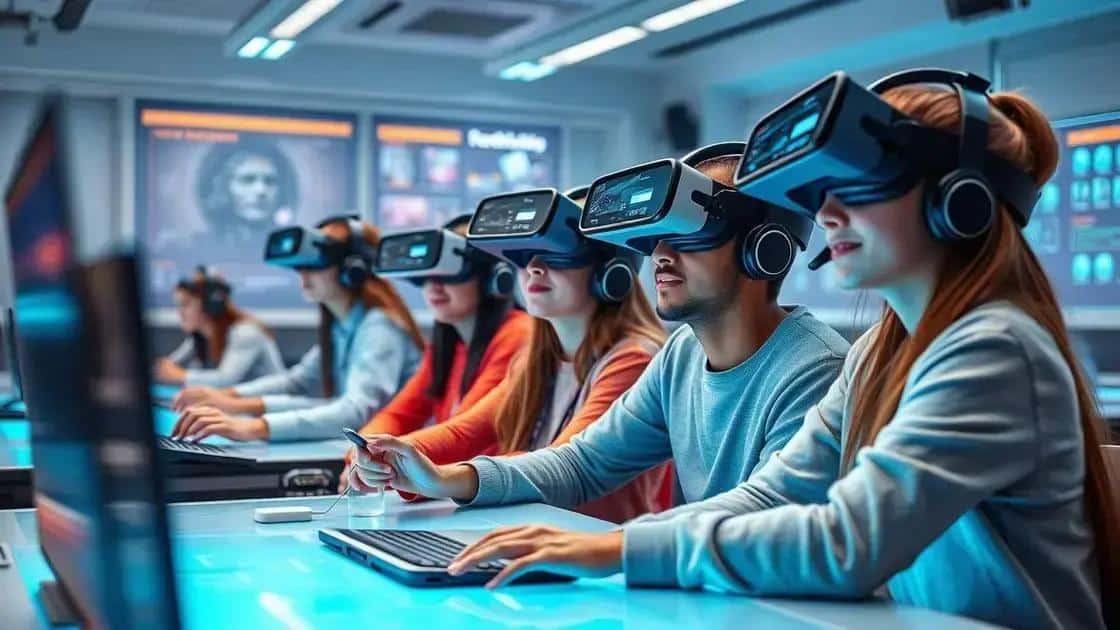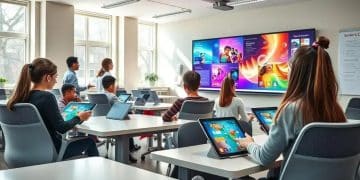Gamified learning platforms trends that will change education

Gamified learning platforms enhance engagement and collaboration by incorporating game mechanics, personalized experiences through technology, and interactive challenges, transforming traditional education into a more effective and enjoyable journey for students.
Gamified learning platforms trends are transforming education in exciting ways. Have you considered how game mechanics can engage students more deeply? In this article, we’ll dive into the latest trends that are making a difference.
Emerging technologies in gamified learning
The world of education is rapidly evolving with emerging technologies in gamified learning. These innovations are making learning more engaging and effective for students of all ages. With the help of technology, educators can create lively, interactive lessons that capture students’ attention.
Artificial Intelligence in Learning
Artificial Intelligence (AI) is playing a crucial role in tailored education. Programs can adapt to individual student needs, providing personalized feedback and resources. This helps learners progress at their own pace, making learning more enjoyable and successful.
Virtual and Augmented Reality
Virtual reality (VR) and augmented reality (AR) are transforming how students interact with learning materials. They allow for immersive experiences that can make lessons come to life. For instance, students can take virtual field trips to distant lands or explore complex scientific concepts through interactive 3D models.
- Increased engagement through immersive environments
- Enhanced understanding of complicated subjects
- Opportunities for collaborative learning
Gamified learning platforms utilize these technologies to foster collaboration and motivate students. By integrating game elements, such as rewards and challenges, learners feel more invested in their education. As technology continues to advance, the potential for gamified learning only expands, offering innovative tools for both teachers and students alike.
Moreover, data analytics plays a significant role in monitoring student progress. Educators can track engagement levels and effectiveness of various gamified elements. This constant feedback loop helps in fine-tuning the learning experience.
Blockchain for Educational Credentials
Another fascinating technology is blockchain, which can revolutionize how educational credentials are stored and shared. By creating a secure, unalterable record of achievements, students can showcase their skills more effectively to future employers. This enhances transparency and credibility in educational attainment.
In summary, the integration of these emerging technologies into gamified learning platforms is creating a dynamic and enriching environment for learners. As we embrace these advancements, the future of education looks promising and engaging, fostering a love for learning in students around the world.
Benefits of gamified learning platforms

Gamified learning platforms offer many benefits that enhance the educational experience. These platforms transform traditional learning by making it interactive and enjoyable. Students are more likely to engage with the material when they feel like they’re playing a game.
Increased Engagement
One of the primary advantages of gamified learning is increased engagement. When students participate in games, they are more motivated and focused. They learn better because they are having fun. This playful approach helps reduce anxiety and makes it easier for students to absorb complex information.
- Games create a sense of achievement.
- Students are more willing to participate actively.
- Positive reinforcement through rewards boosts motivation.
Moreover, gamified platforms often provide instant feedback, which is vital for effective learning. Students can see their progress in real-time and understand areas for improvement. This immediate response encourages them to keep trying until they achieve their learning goals.
Enhanced Critical Thinking Skills
Another significant benefit is the development of critical thinking skills. Gamified activities often challenge students to solve problems, think strategically, and make quick decisions. These skills are essential not just in academics, but also in real-life situations.
By engaging with these challenges, learners understand the consequences of their choices, fostering a deeper comprehension of the subject matter. This hands-on problem-solving approach cultivates a mindset ready to face future challenges.
Collaboration and Social Skills
Gamified learning also promotes collaboration. Many platforms encourage teamwork, allowing students to work together towards common objectives. This interaction helps build important social skills like communication and teamwork.
By collaborating, students learn to appreciate different perspectives and approaches. They build lasting relationships with peers while learning valuable lessons about sharing and compromise.
In summary, the benefits of gamified learning platforms are numerous. They promote engagement, critical thinking, and social skills, creating a well-rounded educational experience. By integrating these elements into learning, educators can make a significant positive impact on students’ lives.
How gamified elements enhance engagement
Gamified elements play a crucial role in enhancing engagement among learners. These elements transform the learning experience by turning educational content into interactive and enjoyable activities. Students find themselves more motivated and eager to learn when immersed in a gamified environment.
Elements of Game Design
Incorporating game design elements like points, badges, and leaderboards can significantly boost student interest. When learners earn points for completing tasks or participate in friendly competitions, they feel a sense of achievement. These elements create a desire to improve and engage more with the subject matter.
- Points encourage learners to strive for better results.
- Badges serve as recognition for accomplishments.
- Leaderboards promote healthy competition among peers.
Each of these gamified elements taps into the natural human tendency to compete and achieve. By providing clear goals and rewards, gamified platforms encourage students to take ownership of their learning journey.
Storytelling and Challenges
Storytelling is another powerful tool in gamified learning. When educational content is woven into an engaging story, students become emotionally involved. They are more likely to remember concepts when they can relate to characters or scenarios. This connection helps students understand complex ideas with ease.
In addition, challenging tasks keep students on their toes. When learners face challenges, they must think critically and creatively to overcome them. This format not only boosts their problem-solving skills but also makes learning more thrilling, as they look forward to conquering each challenge. As they progress through various levels or missions, they build a sense of accomplishment.
Through gamified elements, the learning experience is elevated from traditional methods. Students are more engaged, enjoy better focus, and develop a positive attitude towards learning. Embracing this innovative approach can make a lasting impact on educational outcomes, ensuring that students are excited about their journey.
Future predictions for gamified education

The future of gamified education appears bright and full of potential. As technology continues to advance, we can expect to see more innovative ways to engage students. Gamification will evolve, integrating richer experiences that cater to various learning styles.
Personalized Learning Experiences
One significant trend in the future of gamified education is the focus on personalized learning experiences. With artificial intelligence, educational platforms will analyze individual student data to tailor lessons and challenges. This means each student gets a unique learning path that suits their pace and interests.
- AI algorithms will provide customized feedback.
- Learning materials will adapt to different skill levels.
- Gamified elements will resonate with individual preferences.
This approach will lead to improved outcomes as students are more likely to engage with content that feels relevant to them.
Enhanced Collaboration through Technology
Another exciting prediction is the increase in collaborative opportunities. Future gamified platforms will likely offer more interactive and social elements that encourage teamwork. Students will be able to work together on challenges in real-time, regardless of their geographical locations.
This collaboration can also foster a sense of community among learners, as they’ll share their achievements and learn from each other. Virtual classrooms will become vibrant spaces that mimic real-world interactions, promoting connections among peers.
Integration of Augmented Reality and Virtual Reality
The integration of augmented reality (AR) and virtual reality (VR) into gamified education is another anticipated trend. These technologies can create immersive learning environments that captivate students’ attention. Imagine science lessons where students can explore the universe or history classes that allow them to step into ancient civilizations.
Such experiences not only enhance understanding but also make learning memorable. Students will find joy in exploring interactive worlds while grasping complex concepts in an engaging way. As these technologies become more accessible, their integration will revolutionize the educational landscape.
Overall, the future of gamified education promises exciting developments. By embracing advances in technology and innovative teaching methods, learners will benefit from more engaging, personalized, and collaborative educational experiences.
FAQ – Frequently Asked Questions about Gamified Education
What are gamified learning platforms?
Gamified learning platforms use game mechanics to make learning more engaging and interactive for students.
How does gamification enhance student engagement?
Gamification enhances engagement by incorporating elements like points, badges, and challenges, making learning feel fun and rewarding.
What technologies are involved in gamified education?
Technologies such as artificial intelligence, augmented reality, and virtual reality are used to create immersive and personalized learning experiences.
Can gamified education improve collaboration among students?
Yes, gamified education encourages teamwork and collaboration through shared challenges and interactive tasks, fostering a sense of community.





